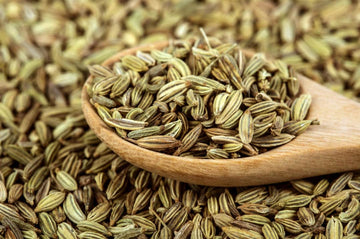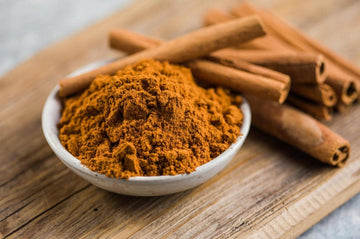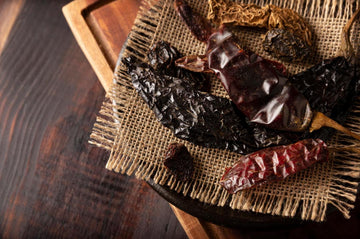Fennel seeds are a small but powerful ingredient found in kitchens around the world, valued for their distinctive sweet, slightly licorice-like flavor and aromatic aroma. These tiny, ridged seeds come from the fennel plant (Foeniculum vulgare), an herb closely related to carrots, parsley, and dill.
Used in both culinary and medicinal traditions, fennel seeds can elevate the flavor profile of savory dishes, baked goods, and beverages, while also offering notable health benefits. Whether you’re grinding them for spice blends, steeping them in tea, or incorporating them into a recipe, fennel seeds provide a fragrant, versatile addition to your pantry.
What are fennel seeds?
Fennel seeds are the dried seeds harvested from the flowering fennel plant (Foeniculum vulgare), a hardy perennial native to the Mediterranean but now cultivated globally. Their flavor is warm, sweet, and subtly herbal, often compared to mild licorice or anise. Visually, they are small, oblong, and pale green to yellow-brown in color, with fine ridges running lengthwise.
In cooking, fennel seeds are prized for their versatility. Equally at home in spice rubs for meats, seasoning for breads, or infusions for teas. They are a staple in Indian cuisine, Mediterranean dishes, and spice blends such as Chinese five-spice and Italian sausage seasoning.
Health benefits
Beyond their culinary appeal, fennel seeds offer a variety of wellness-supporting properties. They have long been valued in traditional medicine for their digestive support, antioxidant content, and mild anti-inflammatory properties. While they are not a cure-all, many cultures incorporate them into daily life for both flavor and well-being, with further health details best explored through professional sources.
How to prepare fennel seeds

Fennel seeds are incredibly versatile, and preparing them properly ensures you get the most out of their naturally sweet, slightly licorice-like flavor. Whole seeds can be used straight from the jar, but to truly unlock their depth, toasting them lightly in a dry pan over medium heat is highly recommended. The heat releases essential oils, intensifying both aroma and taste, while adding a gentle nuttiness. Be careful not to over-toast, as they can turn bitter if scorched.
For ground fennel, always grind the seeds just before use rather than relying on pre-ground spice from the store. This keeps the flavor vibrant and prevents the aromatic compounds from fading. You can use a spice grinder, mortar and pestle, or even the back of a sturdy spoon against a cutting board. The grind size will depend on your recipe. Coarse for rubs and marinades, fine for baking or blending into sauces.
In some dishes, such as pickles or infused oils, fennel seeds are best left whole so their flavor releases slowly over time. For soups, curries, and braises, crushing the seeds slightly before adding them helps distribute the flavor evenly throughout the dish. You can also soak fennel seeds briefly in warm water to soften them for herbal teas, digestive tonics, or salad dressings, which mellows their intensity and adds a more rounded sweetness.
By experimenting with toasting, grinding, and soaking, you can tailor fennel seeds to match the exact flavor and texture your recipe calls for, whether you want them as a subtle background note or a bold, aromatic star.
Common uses for fennel seeds
Fennel seeds have a remarkable ability to work across both sweet and savory dishes, lending a warm, slightly sweet aroma that can brighten a recipe or deepen its complexity. In cooking, they’re often used whole in spice blends like garam masala or Italian sausage seasoning, where they infuse the dish with a gentle licorice undertone without overpowering other flavors. Sprinkling lightly toasted seeds into vegetable sautés or stir-fries can add an unexpected layer of flavor, while crushed seeds work beautifully in dry rubs for meats, poultry, and even fish.
In baking, fennel seeds can be folded into bread dough, biscotti, or spice cakes, where their aromatic qualities balance rich and buttery notes. They are also a common ingredient in traditional spiced cookies and pastries, particularly in Mediterranean and Middle Eastern cuisines. The seeds’ natural sweetness pairs well with citrus zest, honey, and warm spices like cinnamon or cardamom, making them a versatile partner in dessert recipes.

Outside of direct cooking, fennel seeds shine as an infusion ingredient. Steeping them in hot water creates a naturally caffeine-free herbal tea often enjoyed for its soothing, digestive properties. They can also be added to brines and pickling liquids, where their flavor gently permeates vegetables, fruits, or even cheeses. In salad dressings, crushing the seeds and mixing them into a vinaigrette brings a subtle anise-like lift that can complement fresh greens, roasted vegetables, or grain salads.
Whether used whole, crushed, or ground, fennel seeds adapt easily to a wide variety of recipes, making them a pantry ingredient that can transform both everyday dishes and special-occasion meals.
Fennel seeds vs. anise
Fennel seeds and anise are often mistaken for one another because they share a similar sweet, licorice-like aroma, but they are botanically distinct and behave differently in recipes. Fennel seeds come from the fennel plant (Foeniculum vulgare), part of the carrot family, and are typically larger, pale green to light brown, and have a milder, more herbaceous sweetness. They carry hints of earthiness alongside their anise-like flavor, which allows them to blend seamlessly into both savory and sweet applications without dominating the dish.
Anise seeds, on the other hand, are smaller, darker, and far more intense in flavor. They are derived from the Pimpinella anisum plant, also in the carrot family, but their flavor profile is sharper, with a concentrated sweetness that can quickly take over a recipe if not measured carefully. This intensity makes anise a common choice in candies, liqueurs like ouzo and anisette, and strongly flavored baked goods.
From a culinary perspective, fennel seeds tend to be more versatile because of their balanced profile, making them suitable for slow-cooked stews, delicate fish dishes, or light teas. Anise, with its boldness, is often used when the goal is to make the licorice note the star of the recipe. While they can sometimes be substituted for each other in small amounts, doing so changes the flavor outcome. Anise will make a dish more aromatic and sweet-forward, while fennel will keep it rounded and subtly layered.
Subtle power of fennel seeds
Fennel seeds are a bridge between delicate sweetness and earthy depth. Their mild, versatile flavor lets them slip easily into everything from rich curries to light teas, offering a quiet complexity that lingers without overwhelming.
Whether you keep them whole, toast them for warmth, or grind them into a fine powder, fennel seeds can shape a dish in ways that are both comforting and unexpected. Understanding how they differ from stronger spices like anise helps you choose the right ingredient for the mood and tone of your cooking, making fennel seeds an enduring favorite in kitchens across the world.
FAQs
How should fennel seeds be stored for maximum freshness?
Fennel seeds should be kept in an airtight container, away from heat, light, and moisture. A cool pantry or cupboard is ideal, and whole seeds will retain their flavor longer than ground ones.
Can fennel seeds be eaten raw?
Yes. Many people chew raw fennel seeds after meals as a natural breath freshener and mild digestive aid. The flavor is more subtle when raw, compared to when they’re toasted or cooked.
Where can I buy fennel seeds?
Fennel seeds are widely available in supermarkets, spice shops, and online retailers. Specialty grocery stores may also carry fresher or more aromatic varieties.




